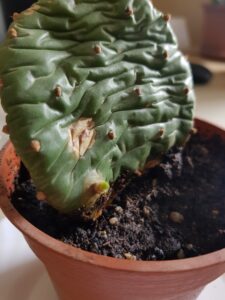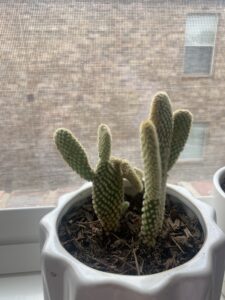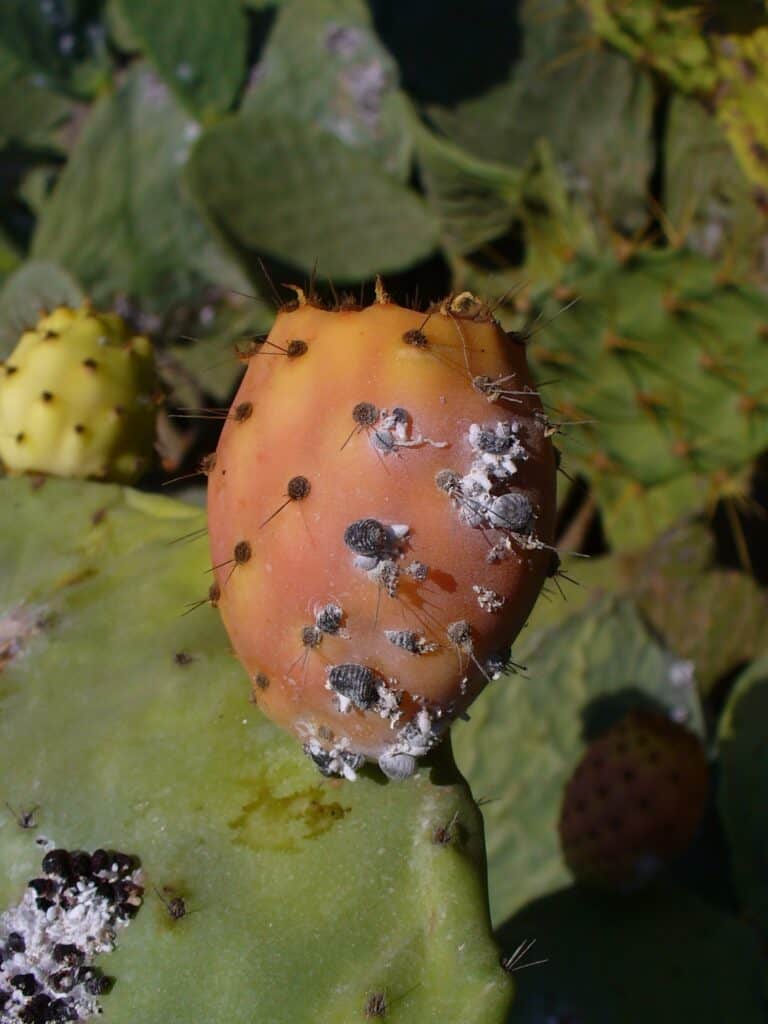Cactus are relatively easy to maintain for beginners. However, if your cactus is shriveling up and wrinkling, it may not be getting enough care.
Before you toss out a shrunken cactus, remember that you can save it before it’s too late.
My cactus plant has been with me for almost two years. In the past, I’ve had similar problems with my cactus.
I was intrigued about why this may have happened, so I did some research and prepared a list of potential causes.
The most common causes of cactus shriveling are improper watering, aging, rotting, and too much light. The root system is the primary concern for these issues. Providing a good balance of water and adequate sunlight and checking out for diseases regularly will solve these issues.
Listen to this article here.

There are many other reasons why it may happen, and this article will explain to you how to deal with Cactus shriveling up and wrinkling.
Read more to know how to take care when your Cactus starts shriveling up and wrinkling.
Table of Contents
What do Shriveling and Wrinkling Cactus Mean? Is it Normal?
Cactus prefer a humid environment, and frequent watering is essential for their proper growth.
Most of them come from dryland areas such as deserts and arid regions of the globe and often require minimal care and effort.
Your cactus is shriveling, but this does not necessarily indicate that it is dying. It simply expresses the distress it is experiencing as a result of environmental factors, insect infestations, illnesses, or nutrient deficiencies.
Cactus shrinking is not typical and should not occur in a healthy cactus. Please keep in mind that aging cactus will usually show signs of corking.
It is not usually typical for the Cactus to shrivel up and start wrinkling.
The following section will give you in-depth knowledge regarding the issues which might have triggered the shriveling and wrinkling of the Cactus.
Common Reasons for Cactus Shriveling Up and Wrinkling
The most important thing is to figure out what’s making the cactus shrivel and wrinkle.
However, it cannot be attributed to a single factor.
Let’s take a brief look at what’s causing your cactus to wrinkle and shrivel.
| Reasons | Solutions |
|---|---|
| Underwatering | Watering the plant on a frequent basis (3-4 days). |
| Overwatering | Using Soak watering technique with proper drainage system. |
| Root Problems | Proper root pruning . |
| Excessive Sunlight | Place the plant away from direct sunlight. |
| Inadequate Fertilizer | Use fertilizer rich in minerals and nutrients. |
| Environmental Impacts | Place the cactus away from the sun, wind. Try not to move the plant much. |
| Pests | Use water jets to kill the insects. Insecticidal soaps and horticultural oils may also be beneficial. |
| Diseases | Treat the plant with fungicide. Careful nurturing of the plant. |
1. Underwatering the Plant
Despite the Cactus being a desert, dry plant, it does require water regularly.
Underwatering a Cactus plant is prevalent and may cause long-term issues.
Lack of water may cause the plant to shrivel up and eventually die.
To carry out the essential transpiration process, minimal watering is sufficient for succulents like Cactus.
Cactuses are grown on loose, fast-draining soils with little water retention because they cannot tolerate standing water or persistently moist roots.
If a cactus starts to shrivel, give it a long, deep drink first — never water a cactus shallowly.

Solutions
- Water your Cactus at least once a week during the summer and only once every 2-4 weeks during the winter.
- Place a wooden stick in the soil and check whether the top 2-3 inches of the soil is completely dry. If it is dry, it indicates it is time to water your Cactus.
- Use an indoor soil moisture meter to check the moisture content of the soil.
- Soak and dry watering techniques can ensure the soil receives enough moisture content for its growth.
- Mist your cactus stems to help them moisturize. The best time to mist is after sunset.
- Placing water near the Cactus causes it to evaporate and be absorbed by the Cactus.
2. Overwatering the Plant
Overwatering Cactus may also bring many root-related issues, as it generally prefers dry soil and less water content.
It affects the vital nutrients and oxygen transport chain throughout the plant system.
Succulents like Cactus hold moisture in their stems, roots, and leaves and tend to survive without external humidity for an extended period.
Hence, we should avoid frequent watering of the plant to ensure its proper growth.
Typically a healthy cactus would have sturdy stems. This may not be the case for an overwatered cactus.
Overwatering may also lead to discoloration of the stem (Chlorosis), which indicates stunted growth and the inability of proper nutrient absorption.

Solutions
- Repot your cactus, give the roots time to establish themselves, and replace the soil with well-draining soil.
- Poke small holes in the soil, allowing extra air to circulate in the roots.
- Place your Cactus in the south-facing window to ensure proper sunlight, which helps the soil dry more quickly.
- Elevate the planter above a saucer to ensure the excess water can easily flow through the drainage holes.
- Place the Cactus in areas of low humidity around the household, ideally away from humidifiers, kitchen, and washroom areas.
- Soak a saucer in water and place the cactus pot on top of it.
- Using a Peat-based mix to ensure water retention in the soil.
- Use free-draining soil such as Hoffman Organic Cactus and Succulent Soil Mix for proper drainage and come equipped with the essential nutrients.
- Ensure that your pot has the proper drainage system.
Quick Note: You should not water your Cactus before and after repotting for up to a week.
3. Root Problems
A cactus, despite being a low-maintenance plant. It does require proper care at times to ensure adequate growth.
Root-related problems are serious for any plant; the same is the case for Cactus.
A healthy root of the Cactus plant will have healthy white roots.
Cactus in pots usually get root-bound and have challenges with nitrogen intake, which causes them to shrivel.
Another issue may be root rot which may cause issues in nutrient and water uptake towards the leaves.
| Root Problems | Causes |
|---|---|
| Root Rot | Water molds caused by waterlogged soil |
| Soft and Mushy roots | Overwatering Fungal infection |
| Root bound | The pot size being too small. |
Solutions
- Remove the plant and check the root to identify the problem.
- Repot your plant in a slightly larger pot than the previous one.
- Always wash the roots off before repotting in a fresh potting medium.
- For soft and mushy roots, you can take cuttings and allow them to root into a new plant.
- Wait for a few days for the cutting to callus before inserting it into the new soil.
- Pruning of the root will help in the restoration of Cactus plants. It may take many weeks to root the cutting.
- Use fungicides for tackling root rot problems.
- Avoid overwatering.
- Use rainwater to water your Cactus because tap water may contain minerals that may deposit in the roots causing the blockage of essential nutrient absorption.

4. Inadequate Sunlight
Cactus do prefer bright lighting for their optimal growth. Your cactus will not thrive if it does not receive enough sunlight.
If it has been exposed to insufficient sunlight for an extended length of time, it will begin to lean, with thinning and elongated growth.
On the other hand, excessive direct sunlight may cause its leaves to burn.
High intensity of sunlight may cause the cactus to lose its water retention mechanism, leading the plant to lose water and become dehydrated, causing it to shrivel and wrinkle.
Quick Note: If you want your cactus to have brilliant coloration, you should place them in direct sunlight for them to reveal their true color intensity.
Solutions
- Provide your Cactus with about 10-14 hours of bright indirect lighting for proper growth.
- Gradually change the lighting conditions around Cactus (slowly increasing time and intensity).
- Even if your cactus is dormant for the winter, make sure it is positioned in a location where it will receive the most sunlight.
- Cover the plant with a semi-transparent cloth to avoid bright direct sunlight.
- Place your Cactus in the south-facing window where it receives indirect sunlight.

5. Inadequate Fertilizer
An adequate amount of fertilizers help Cactus become healthier and more robust.
It also helps the Cactus receive the required amount of micro and macronutrients essential for its growth.
Yes, inadequate quantity and concentration of fertilizer are also the reason your Cactus may be shriveling up and wrinkling.
During the active growing period (summer), the Cactus prefers more fertilizer than other months.
The ideal fertilizer for a cactus is one that has a greater amount of phosphorus.
To gently feed your cactus, use a balanced combination of vital nutrients with low NPK rates.
It aids and increases root development, color vibrancy, gorgeous bloom, and stem growth.
Cactus often prefer a low concentration of fertilizer for their optimum growth.
Solutions
- Providing Cactus with organic fertilizer, low doses of NPK fertilizer, preferably a 5-10-5 ratio every three months or preferably once during the summer season.
- Introduce probiotics and Mycorrhizae into the soil to help your cactus to live longer.
- Using citric acid, acetic acid, and potassium dihydrogen phosphate to tackle the issues regarding deficiency-related diseases.
Recommendations for Fertilizers
- Succulents & Cactus Plant Food
- Miracle-Gro Succulent Plant Food
- Schultz Cactus Plus 2-7-7 liquid Plant Food
6. Temperature Extremities
Despite being a low-maintenance plant, Cactus cannot tolerate extreme changes in their daily environment.
Like any other indoor plant, Cactus dislike being moved around because it is stressful to change the environment frequently.
Higher temperature leads to a higher transpiration rate which needs higher water intake.
Cactus cannot survive in temperatures below -20°F, but some species cannot tolerate temperatures below freezing.
Whereas on the upper end, the Cactus cannot survive in temperatures above 90°F.
The ideal temperature for cacti will be around 45-85°F, which is most suited for their growth and development.
If your cactus is placed near a window, it may shrink as a result of sunburn or freeze as a result of direct contact with the glass.
Lower temperature causes the water stored in the stem and leaves of the Cactus to freeze and survive the winter months by remaining dormant.

Solutions
- Place the plant away from direct heating or air conditioning vents.
- Place the Cactus away from direct sunlight and air from the window.
- Please do not place the Cactus behind filtered glass where sunlight can pass through, as it intensifies the light.
- Cover your Cactus with a plastic sheet if placed outside during the winter months to protect it from frost and cold wind.
7. Pest-Related Issues
Scale insects, mealybugs, and nematodes are the most common pests found in household Cactuses.
These pests take away vital nutrients and water from the plant and may cause the plant to shrivel.

Removing the pests will ensure proper growth of the Cactus and prevent shriveling and wrinkling.
It may be difficult to identify mealybugs from actual Cactus tissue as they look quite similar.
Here are a few of the common pest infestations in Cactus, along with their solution and preventive measures.
| Pests | Identification |
|---|---|
| Mealybugs | 1. Grows around the base of cactus 2. White fluff like substances |
| Red Spider Mites | Hide under cactus leaves |
| Scale Insects | 1. Found attached to outer layer of cactus 2. Feeds on vascular tissue 3.Use needle like mouth to pierce outer surface |
Solutions
- Use systemic insecticides such as imidacloprid or acetate.
- Apply Neem oil or Horticulture oil.
- Prune the affected stem and leaves of the Cactus to minimize the spread.
- Wash away pests like mealybugs and spider mites with a strong jet of water.
- Make use of yellow sticky insecticidal strips.
- Use a 1:1 ratio of water and rubbing alcohol and spray it on the affected area of the cacti.
Preventive Measures
- Avoid Chamaecyparis leylandii near your household, as red spider mites proliferate on them.
- Introduce natural predators of the red spider mites, such as ladybugs and lacewing, as part of biological pest control measures.
8. Fungal Diseases
Cactus are prone to many fungal diseases, which lead to rotting stems and drying out the plant.
The rotting caused due to diseases may lead to the Cactus shriveling and wrinkling.
Factors such as low temperature, overwatering of the plant, direct sunlight, and lack of nutrients may also cause freezing, sunburn, and nutrient deficiency.
The most common diseases in the Cactus include rotting and deficiency-related conditions.
| Disease | Causative Organisms | Symptoms |
|---|---|---|
| Cactus Mosaic Virus | Aphids | Yellow colored spots |
| Bacterial Soft Rot | Erwinia amylovora | Brown spots on leaves, stem. |
| Foot Rot | Pythium aphanidermatum | Brown, wet spots. |
| Fusarium Rot | Fusarium oxyporum | Plant turns grey, stem begins to wrinkle. |
Solutions
- Apply fungicides to the infected parts in the early stage. Repeat this process every 3 to 4 hours.
- To treat soft grey rots, cut out lesions, and apply coal nystatin and colloidal sulfur. This process is effective only when the disease is in its early stage.
- For Black rot, spray the plant and the soil with Oxyhom.
- Cut off the plant parts that are infected by the fungus.
- Apply activated charcoal, colloidal sulfur, or green grease to the wounds.
Preventive Measures
- Prune the Cactus to prevent infection in other areas of the plant.
- Disinfecting the pots and tools to minimize the risk of infection.
- The soil must be disinfected before planting.
- Ensure a proper watering schedule.
- Make sure to check your Cactus regularly to check for any injuries or yellow/brown marks on the leaves and stem.
Quick Fact: Fusarium Wilt in Cactuses cannot be treated.

Conclusion
Next time you see your Cactus shriveling up and wrinkling, remain calm and identify the cause; then, you may take the actions mentioned above to keep your Cactus healthy.
It requires minimal attention and care, so it is the best plant to start your indoor plant’s journey with a cactus.
To ensure that the plant improves and survives, make minor changes and check its health regularly.
After knowing these tips and tricks, I am sure you will provide the perfect care for your Cactus.
Talking about tips and tricks, you might also be interested to read about 14 Tips for Pincushion Cactus Care.
Also watch,


